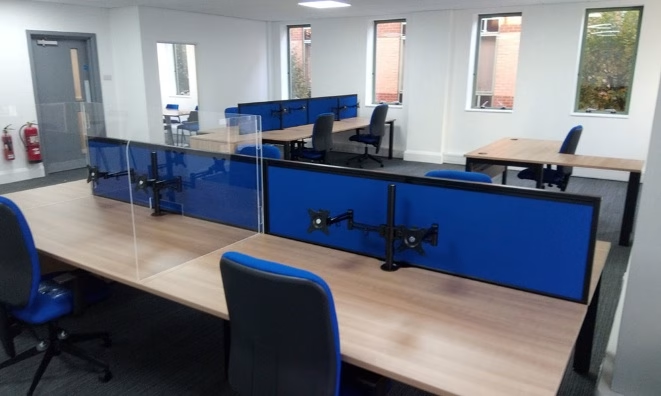The way we work has changed, and so have the spaces we work in. As hybrid working becomes the norm rather than the exception, office design is evolving to meet new expectations around flexibility, collaboration, and wellbeing.
At Bluewood Interiors, we’re seeing a clear shift: businesses are rethinking their workspaces not just to accommodate hybrid teams, but to actively support them. Here’s how office design is adapting to the future of work.
From Fixed Desks to Flexible Zones
The traditional “one desk per person” model is giving way to more dynamic layouts. With many employees now splitting their time between home and office, businesses are reconfiguring space to reflect actual usage.
In fact, only 22% of workers now attend the office five days a week, while 38% attend just one or two days. This shift is driving demand for:
- Hot-desking and touchdown areas for occasional office users
- Collaboration hubs designed for in-person teamwork
- Quiet zones and focus pods for deep, individual work
This activity-based approach ensures every square metre of space serves a purpose, whether that’s brainstorming, concentrating, or connecting.
Technology-Ready Spaces
Hybrid work relies on seamless digital collaboration. That means office design must now integrate technology from the ground up.
Modern hybrid offices include:
- Video conferencing rooms with high-quality AV
- Interactive whiteboards and digital collaboration tools
- Smart booking systems for desks and meeting rooms
With 80% of office occupiers now sustaining hybrid work policies, tech-enabled spaces are no longer optional, they’re essential.
Design That Supports Wellbeing
With fewer days in the office, employees expect more from the time they do spend there. Comfort, wellbeing, and a sense of purpose are now central to workplace design.
Design strategies include:
- Maximising natural light and biophilic elements
- Ergonomic furniture and adjustable workstations
- Social spaces that encourage informal interaction
Employees working from home report spending 24 minutes more on rest and 15 minutes more on exercise per day compared to those in the office. To compete, the office must offer a compelling, health-supportive environment.
Modular, Adaptable Layouts
Flexibility is the defining feature of the hybrid workplace. Offices must be able to evolve as team sizes, work patterns, and business needs change.
There is growing demand for:
- Modular furniture that can be reconfigured easily
- Movable partitions to create or remove enclosed spaces
- Multi-use rooms that shift from meetings to workshops to quiet zones

(https://bluewoodinteriors.co.uk/wp-content/uploads/2024/02/bluewood-HMM-Europe-project.jpg)
Conclusion
Hybrid working isn’t a temporary trend; it’s a long-term shift in how we think about work. And office design is rising to meet the challenge, blending flexibility, technology, and wellbeing into spaces that support people and performance.
At Bluewood Interiors, we help businesses create workspaces that are ready for what’s next. Whether you’re rethinking your layout or planning a full fit-out, we’ll help you design for the future of work.
Get in touch with our expert team today at info@bluewoodinteriors.co.uk or give us a call on 02380 001 167.

